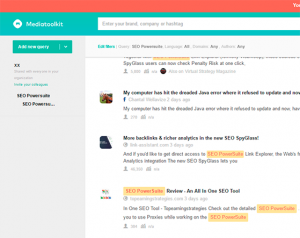
The road to advanced SEO is long and exciting. There are significant milestones during the journey to becoming a master SEO blackbelt. From barely knowing what SEO stands for to orchestrating custom experiments, a lot of growth happens!
What’s your SEO belt level? Are you ready to move up to the next one? Here’s what you can expect to experience on your journey through the seven belts of becoming an SEO ninja.
White Belt: Your First Introduction to Search Engine Optimization
You want to make a serious website but either haven’t started yet, or you’ve started and failed. Through failure or intimidation you realize that you don’t know what you don’t know. You look up “how to rank in search”… then immediately look up what “SEO” means. The amount of information seems endless and intimidating at this point.
For more training:
- Curb some intimidation with this simple guide.
- Learn to start doing SEO with this post from TrendBlog.
Yellow Belt: Knowing What You Don’t Know
SEO is a prominent part of your current vocabulary. The Google Keyword Planner Tool rocks—what a head start! You copy keywords into a spreadsheet, along with search volume. You don’t fully understand what “Keyword Competition” is, but you know for sure that you want low competition and high search volume.
Another thing you aren’t clear on is why you can’t use a lot of keywords. You know that it’s a black hat technique but that’s about it.
You like the Yoast SEO Plugin because it helps you remember everything you need to optimize on a page. There’s a lot that goes into on-page SEO, so this tool is a big help.
For more training:
- Visit the Yoast blog for information about different SEO topics like Content SEO and General SEO.
Orange Belt: Starting to Understand Why
Matt Cutts is a freaking genius!
Keyword stuffing is bad because it cheapens your content quality. In fact, putting keywords in the footer is bad—so is buying links, duplicate content, and having low word count. You’ve mastered these and about a dozen other SEO ranking factors.
You basically understand black hat and white hat SEO, but you don’t have a strong strategy to ensure top performance SEO practices.
What are canonical tags? When would someone set up nofollow/noindex tags?
Structured data is starting to make sense, or at least you feel like it is. You work with designers and developers to make sure there’s quality content above the fold and that page titles keep keywords towards the beginning. You understand the importance of using alternative text in images for users who need a screen reader, but mainly focus on the benefit of it within image search.
You’ve heard that meta descriptions don’t really impact SEO directly, but they kind of do somehow? Also, subdomains can be a good way to separate site data, but it can also hurt SEO… you think (still figuring this one out).
For more training:
- Get a better grasp of structured data. The Schema.org Structured Data resource from Moz has tons of great information, tools, and external resources to help you own structured data markup.
Green Belt: Seeing a Hint of Advanced SEO Through Observing Trends
At this point you have a pretty firm understanding of using schema.org structured data to put semantic context around your content. Your goal is to have a fully customized knowledge graph so that when you rank you seriously own the page. You add code for events, products, reviews, apps, and more like a guru of knowledge graph manipulation.
Maybe putting keywords at the beginning of titles isn’t as important as you originally thought.
Crawling websites with various tools to find ideas for newer, stronger keywords can give you powerful data-driven insights to keyword research by identifying how your competitors are ranking for a given keyword and where it appears on their site.
You use Search Console and Raven to compare keywords that people are actually using to find your website. You compare impressions and clicks for each keyword while being able to weigh these metrics against local and global keyword search volume. Maybe search volume isn’t the more important driving factor of traffic to your site.
You feel like your strategy is stronger than ever, your intention is clarified, and you WILL find the best keywords no matter what!
For more training:
- Start looking into semantic based keyword research to begin peeking into the meaning behind the keywords. Here’s an awesome slideshare by Catalyst Digital to help you get into the headspace.
Blue Belt: Taking SEO to the Next Level
Rand Fishkin is a freaking genius! You can’t wait for Whiteboard Fridays—it’s an important part of your Saturday morning ritual.
Keyword strategy and strategic markup are second nature now, and you own backlinking strategy:
- You pick apart your backlinks and the backlinks of your competitors using at least three backlink tools because you know that diversifying your research gives you better results.
- You contact people who misspell your company name in anchor text and ask them to use your company name spelled correctly—or better yet, with KEYWORDS!
- You compare your backlinks to your competitors to find opportunities for growth.
- You help fix broken links on certain sites in hopes of gaining a backlink.
Your posts are syndicated and you’re seeing an increase in traffic.
You self-canonical tag everything unless there’s a strategic reason not to, and in those cases you set a canonical and non-canonical page.
While keyword-optimized meta descriptions don’t impact SEO directly, they influence other factors that do. The concept of website behavior is becoming very important to you and your efforts.
UX is way more important than you could have ever imagined and you start looking at tools like xSort or OptimalSort. Good Information Architecture complements a good UX and you see how that’s more important than a mechanically SEO’d website.
A well structured website augments your SEO efforts. You leverage internal linking to enhance crawlability from bots like the Google Bot.
By this point, you’re working with developers and content creators frequently.
You see some reasons to use subdomains, but for the most part you try to avoid them.
For more training:
- Take a look at Rand Fishkin’s blog on the Moz website.
Brown Belt: Becoming Nimble with Technical SEO and Complex Data Analysis
All of your sites are intentionally optimized while not being over-optimized. You’ve mastered the balance of well crafted organic and optimized content. Your SEO isn’t robotic anymore.
You let people use whatever anchor text they want without asking them to fix it because you know that Google observes your repertoire of backlinks and having spelling errors or irrelevant keywords actually makes you look like a part of the internet community.
The Yoast plug-in is a guide, not doctrine.
You begin to wonder why Rand Fishkin is such a genius. You don’t entirely trust Matt Cutts.
Page depth per session is a focus of yours. SEO is only the beginning. You understand its purpose is to rank in search and to drive traffic. But then what? You’re focused on CRO and you deeply care what people are doing on your site.
You pay attention to demographics and track the behavior of your most qualified visitors. You’ve moved past increasing visitors—in fact, if anything, you think you might have too many unqualified visitors.
You do keyword research less frequently, and when you do you’re focusing on searcher intent. Your efforts are all about the visitors now.
You pick apart visitor flows, goal funnel visualization helps identify the meaning behind visitors’ actions, and heat maps are a way of life.
Time on page, pages per session, entrance pages, exit page, and the multi-dimensional analysis of them are effortless.
You rely on data, UX tools, and website psychology to drive conversions to the stratosphere by heavily focusing your strategic efforts on ingenious CTA placement and design.
As a brown belt, you respect the importance of keyword research, but it’s a grain of sand on a beach.
For more training:
- Create a website and start growing through self-guided research. It’s time to perform some experiments of your own.
Black Belt: Creating a Universe of SEO Mastery Through Experimentation
Backlinking is more like PR. You collaborate, and encourage your clients to do the same, with like-minded organizations to perform studies to create knowledge that you can share together to build authority while gaining brand awareness. You incorporate quality work of professionals that you respect—even the parts that weren’t officially published.
Matt Cutts is alright. You comprehend the complexity of SEO and understand that the answers he supplies are as true as they could possibly be. Having one source with all the answers is irrational, especially since Google admits to not fully understanding how some of their ranking functions work.
You’re comfortable saying “I don’t know” if a client asks you a specific question that you don’t know the answer to.
You run SEO experiments on your website to test SEO concepts that you’ve read about—partly because you can’t rely solely on expert insights anymore. Using fancy tools in stand-alone research is insufficient without having context that’s relevant to your exact purpose.
Digital & Social Articles on Business 2 Community
(167)
Report Post








